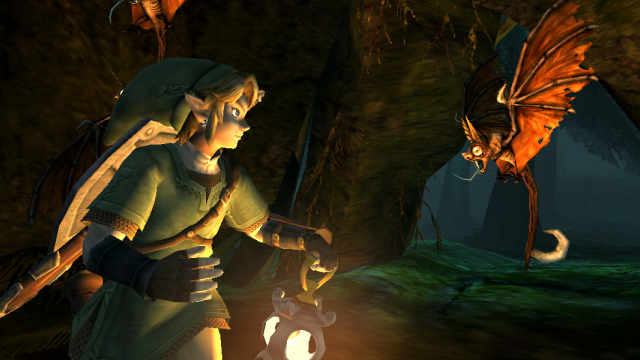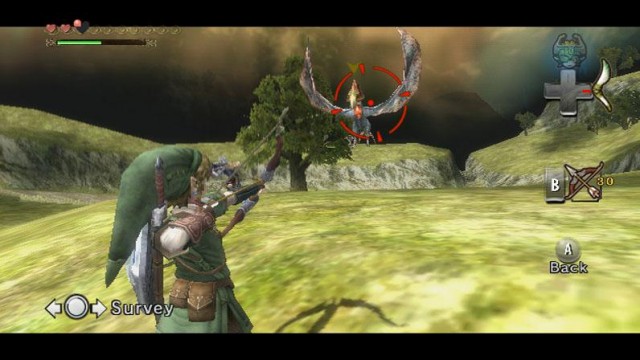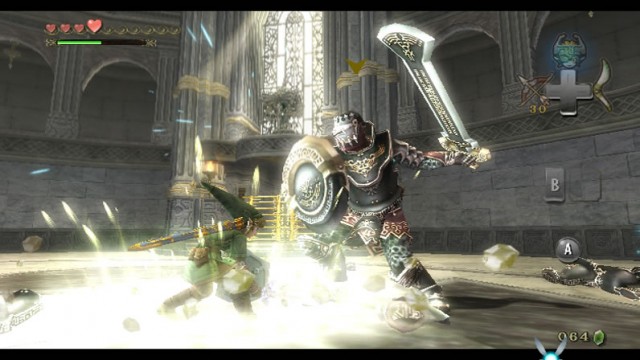
Wii was something of a cultural phenomenon when it first debuted. Nintendo had done a remarkable job generating anticipation for the system thanks to its unique remote-shaped controller and its pack-in juggernaut Wii Sport, which captured the imagination of gamers young and old with its motion-controlled gameplay. But while Wii Sports turned the console into a household item and opened the medium up to those who had never before played video games, it was The Legend of Zelda: Twilight Princess that defined the system’s launch and set the precedent for how to incorporate motion controls in a traditional gaming experience.
On the surface, Link’s foray into a darker, grittier Hyrule may have seemed like blatant attempt to distance the series from the bright, seafaring adventure of The Wind Waker, and to a certain extent, it was. Wind Waker had caused a deep rift in the Zelda fan base when it debuted thanks to its low difficulty and cartoony visuals (not to mention reinforced Nintendo’s kiddy image, which hurt the company’s credibility with Western gamers, who were becoming an increasingly important segment of the gaming population). Nintendo sought to rectify these criticisms with Twilight Princess, eschewing Wind Waker’s colorful art style for a more subdued and realistic aesthetic, increasing the difficulty of the game’s dungeons, and crafting a more somber tale to serve as the catalyst for your journey.
The end result was a game that felt more conservative than its cel-shaded predecessor, but that safeness belied just how engaging it was. Twilight Princess may not have been as visually daring as The Wind Waker, but it was a much more refined game, making up for its familiarity with rock-solid gameplay. Dungeons were more plentiful and better designed than in Wind Waker, culminating in some of the most memorable boss battles in the entire series. Likewise, Link’s arsenal was more varied and better utilized throughout the game, making the items he acquired less like glorified keys and more like unique power-ups that he could equip at any point during his quest.

But perhaps the most impressive aspect of Twilight Princess was its version of Hyrule, which was the most beautiful rendition of the kingdom in any Zelda game to date. Hyrule Field was breathtaking in its scope, encompassing a wider variety of terrain than it did in previous titles. The sprawling meadows of the Faron Province were already larger than the entirety of Ocarina of Time’s hub area, but they made up only a small portion of Hyrule’s geography. Head further north and the verdant greens of Faron bled into the reddish browns of Eldin, which in turn gave way to the grey mountain faces of Lanayru, where Hyrule Castle Town, the heart of the kingdom and the scene of the game’s climactic final battle, was located.
Each province was also dotted with its own unique landmarks, which gave the environments a distinct sense of history. Seeing the Great Bridge of Hylia for the first time, its support columns dangling above Lake Hylia like giant, man-made stalactites, was one of the most awe-inspiring moments in the series, as was the first time you set foot in the Arbiter’s Grounds, its colosseum-like walls moldering in the hot sands of the Gerudo Desert.
Of course, the game’s strengths extended beyond just its cosmetic flourishes. Swordplay was also vastly improved in Twilight Princess, offering the most nuanced combat in the series to date. This, too, felt like a direct response to Wind Waker, whose parry system had effectively reduced battles to quick-time events. You still had full control over Link’s attacks just as in any previous Zelda game, but the most effective– and certainly the most expedient– way to dispatch foes was to wait until the A button lit up, which would launch the elfin hero into an unstoppable finishing move.
Twilight Princess retained these super attacks, but rather than unleashing them with the press of a button, they were scattered about the game as hidden techniques which had to be learned and manually executed during battle. This gave players a greater degree of control in combat, turning each encounter into a graceful dance between you and your opponents: you could make quick work of your foes by incapacitating them with a shield bash and following up with a helm splitter, or you could wait until one drew near enough to finish off with a devastating mortal draw. If your foe was heavily armored, you could dodge its attack with a quick roll and leap into the air with a back slash, removing its breastplate and leaving it susceptible to further attacks. The sheer range of options at your disposal made each battle exciting and unpredictable.

This was further enhanced by the Wii Remote, which brought a new dynamic to the gameplay. Twilight Princess may not have had the benefit of the Wii MotionPlus (which improved the Wii Remote’s accuracy and allowed for near 1:1 swordplay in future Wii titles), but it nevertheless made great use of the controller’s features. Sword attacks were initiated with gestures rather than button presses, making combat more physically immersive than ever before. Link’s swipes may not have directly correlated with your movements, but the novelty of swinging the controller to attack foes was enough to compensate for its inaccuracy.
Where the Wii Remote really proved its worth, however, was in archery. Aiming became far more intuitive thanks to the remote’s pointer functionality, allowing you to snipe at targets with pinpoint accuracy. This made the bow one of the most invaluable weapons in your arsenal, as you could take out foes and activate switches quickly and easily, regardless of their distance.
While its eventual followup Skyward Sword would make even better use of the Wii Remote (and would finally realize the potential of motion controls in a traditional video game), I still consider Twilight Princess to be the better of Wii’s two Zelda games. The title may have had its missteps; its introductory chapter was poorly paced, and the wolf mechanic, despite some clever uses, was a bizarre gimmick that added no real value to the gameplay. But even with these blemishes, Twilight Princess was an excellent installment of the legendary series, one that could stand proudly alongside later classics such as Super Mario Galaxy, Metroid Prime 3, and Xenoblade Chronicles (among many others) as one of Wii’s finest titles.




 ShareThis
ShareThis







I really would like to go back to this game at some point. I beat it, but there’s a lot that remains kind of fuzzy in my memories of it.
Of course, I should probably pick up Skyward Sword again instead, since I never finished that one at all.
I have very mixed feelings about Skyward Sword. There were some things that I really enjoyed about it (like the sword controls and the soundtrack), but there were others that I absolutely LOATHED, which probably outweigh the things I liked. XD
Still, I think it should be experienced at least once all the way through, so I’d say go for it!
Twilight Princess is a Gamecube Game. The Wii’s ported version is tainted. Granted the Wii version has a pretty widescreen mode. However the tacked on motion control (yes, even aiming your bow), mirrored world, and right handed Link just serve as a reminder that it was developed almost completeley for another system (the Gamecube) and was hastily ported to Wii as a result of Nintendo’s historically slow and long development cycles. Just like playing NES games with a Wiimote on the virtual console will never be as good an authentic NES gamepad, the Wii version of Twilight Princess is just “off.” Yes I’ve played through each version to completion and this is just my opinion.
Considering that Nintendo did its best to bury the GameCube version (not only by releasing it after the Wii version by over a month, but by giving it such a limited print run), it’s effectively a Wii game, and I think history will remember it as such. ;P
To be honest though, I was seriously considering picking the GC version over the Wii one when it was first released, since it was designed foremost for that system. But after playing it at a Wii demo kiosk, I was immediately sold (as you can probably see from the article). I do wish I got to play the GC version as well, if only for reference, but I know that after experiencing it on Wii, I never want to aim with an analog stick again. ;)
I wouldn’t say the Wii version is “tainted” per se. Its motion control may feel tacked on (let’s be honest, we all wanted something like Skyward Sword at launch in terms of motion control!), but I think it’s still far more accomplished than other launch games like Red Steel that were developed specifically for the system.
I agree that “it’s still far more accomplished than other launch games like Red Steel that were developed specifically for the system.” Well of course it was. It had the benefit of a multi-year development cycle for Gamecube before a hasty switcheroo by Nintendo. Yes, it will be remembered as a Wii game for sure (it already is.) But that’s based on circumstances not involving the merits of the different versions. As was alluded to, the Gamecube version was totally under the radar and pretty much an afterthought by the time it launched.
My point was that (again just an opinion) it is superior in every way on its intended system (except for the beautiful widescreen mode on Wii.) I’m not anti-motion controls. In fact, playing and loving every second of Skyward Sword only serves to expose the Wii port of Twilight even further as it demonstrates the clumsy and hurried implementation (see: tacked on) of “motion controls.” I can see Kevin’s point about not wanting to aim with analog anymore, however as I played the Wii version (for reference after playing the intended Gamecube version first), I couldn’t help but laugh out loud at the the “waggle” sword controls. This was a new low.
Much respect to all of you. I figure in a lot of ways, people are going to like whatever version they either play first, or spend more time with. That being said, I’d take either version over many many other games.